Pros
Cons
Introduction
Physical Tour
The D60 is a handsome, straightforward camera that straddles the line between delightfully compact and annoyingly shrunken. To achieve its diminutive design, a top-mounted LCD readout and second control knob went by the wayside. A point-by-point analysis, though, proves that everything you need to shoot in fully automatic or more manually-controlled modes is included and easy to find.
**
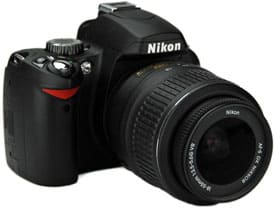
Front(6.25)
Your membership in the brotherhood of Nikon shooters is proudly announced by the company logo atop the viewfinder hump, the silver D60 badge at top right and the trademark red swath on the handgrip, just below the shutter release.The grip material is slightly textured hard plastic.There's an infrared receiver (which works with the optional ML-L3 wireless remote control) on the front of the grip, and a large autofocus assist light (which also blinks during self-timer shooting) between the grip and the lens mount.The lens release button is found on the right side of the lens mount.
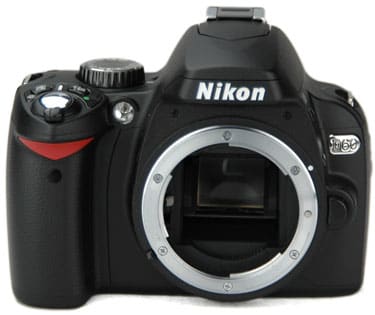
The distinctive Nikon brand look extends from top-of-the-line
to less expensive models.
Back (7.00)
The 2.5-inch, 230,000-pixel LCD is positioned toward the left side of the camera back. To its left is a vertical row of buttons: from top to bottom they are Playback, Menu, Thumbnail Playback / Playback Zoom Out / Help, and Playback Zoom In / Information Display.The viewfinder is above the LCD with a diopter control on the right. The viewfinder is surrounded by a rubber eyecup.Below the viewfinder is a sensor that automatically turns the LCD display off when you hold the camera up to your eye.
The autofocus/auto exposure lock button is between the viewfinder and the command dial on the right side. The circular four-way controller, with an OK button in the middle, is to the right of the LCD. The delete button, with its distinctive trashcan icon, is found below and to the left of the command dial.A small light indicating image recording and noise reduction activity is to the right of the delete button. There's a prominent ridge on the right-side of the camera back to help maintain a steady grip (to rest against the right side of your thumb) and an indentation directly above the four-way contoller (for the ball of your thumb).
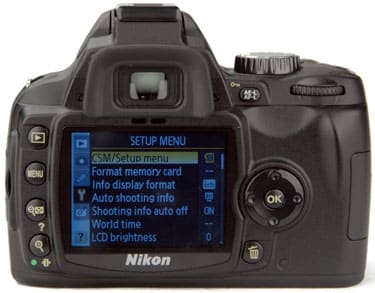
The LCD of the D60 is bright and easy to read.
Left Side* (5.25) *At the back edge, a pop-off cover reveals the USB and video-out ports – a thin plastic tether keeps the cover from falling off when opened. Above it is a flush-mounted metal strap lug. Threading the strap through was a challenge, eventually conquered by grabbing the barely protruding end with a pin and tugging it through.
Below the viewfinder hump are two small buttons.The top button pops up the built-in flash and accesses flash exposure compensation settings.The bottom button triggers the self-timer by default, but can also be programmed to set release mode, image quality, ISO, and white balance when used in conjunction with the command dial.

The USB and video ports are protected by a pop-out door.
A simple ridged door provides access to the SD card slot. The door slides back with a flip of the thumb, then pops up out of the way to allow card insertion – quick and easy to manipulate, yet unlikely to be opened accidentally. A barely visible pull-out cover at the center bottom conceals a connector for the optional EH-5a AC Adapter.This cover is harder to maneuver, requiring a well placed fingernail in a very slim space.

The SD card slot cover slides back and pops out.
The exposure compensation button, which doubles as an aperture control toggle in manual shooting mode, is located on the right behind the shutter release.The active D-lighting toggle, which does double duty as a default values reset button, is on the left behind the shutter.
The metal tripod socket is conveniently centered under the lens axis, allowing access to the battery compartment door even when the camera is mounted on a tripod (the latched battery compartment door is located under the hand grip).The ridged hard plastic bottom is prone to scratches, though, particularly when tripod-mounted.

The battery can be removed even with the camera on a tripod.
Testing/Performance
This is the section of our report where we put the D60 through intensive laboratory testing to determine image quality performance relative to the hundreds of other cameras we've tested.
Overall the D60 tested well for a camera in its price range. While its color performance is underwhelming, its low-noise shooting results make it a good choice for large-scale prints or substantial enlargments of small sections of an image.And with a processor that's been upgraded from its D40x predecessor, we were impressed with the snappy performance figures for fast shooting and image processing.
**Color **(5.08)
Colors captured by the D60 aren't reproduced as accurately as we'd hoped, particularly in the blue and purple parts of the spectrum.Skin colors are likely to look about right, but skies, water, and other bluish tones could be noticeably off.The Nikon also tends to oversaturate colors, giving them an unnatural Kodacolor-style warmth.This boosted reality may appeal to certain consumers, but it isn't an accurate reproduction.
To test color accuracy we photograph an industry-standard GregtagMacbeth color chart under tightly-controlled lighting conditions.The resulting images are scrutinized using Imatest, a sophisticated image analysis program. This computerized process can determine how closely the camera reproduces known colors from the test chart.The results include numerical scores and the following test chart:

The 'ideal' is the original chart color, the outer rectangle wha the D60 captured.
**In this chart, the outer border of each rectangle represents the color captured by the camera, while the inner square displays the color after luminance correction has been applied.The vertical rectangle shows the standard color as depicted on the color chart.
A second chart produced by Imatest provides further information regarding color accuracy, including statistical results.The squares represent the ideal color values as shown on the color chart, and the circles indicate the color values as captured by the camera.The shorter the distance between the square and the circle for each color, the more accurate the reproduction.

*The squares represent the original chart color, the
circles represent what the D60 captured.
*
If you value accurate color reproduction, the D60 is not your camera. The similarly-priced Canon XSi performs particularly well in this area, surpassing even the generally excellent Nikon D300, so there's no shame in failing to match that lofty standard. But the D60 scored worse in this area than the Nikon D40, which has been on the market for nearly two years and can't match the processing power of its new brandmate.
The only saving grace here: consumers don't notice most color accuracy flaws unless the original subject and the photograph are seen together. The color the D60 captures will look fine to most users, but you would definitely notice the superior color of the XSi if you looked at photos from the two cameras side by side.
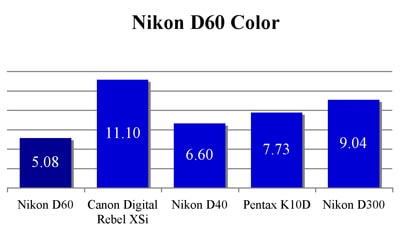
The D60 was tested with the color space set to the default sRGB color mode, which Nikon recommends for nature and landscape shots.The camera also supports a second sRGB mode, recommended for portraits, and the Adobe RGB color space, best suited for images destined for professional color printing.
In this test, we look at the amount of detail a camera can capture. Image resolution is measured based on a measure called line widths per picture height (lw/ph) – the number of distinct alternating black and white lines the camera can capture.There is more to resolution performance than the megapixel count of the camera's sensor. The raw data produced by the sensor has to be processed by the camera's circuitry, which can have a dramatic impact on the final image resolution. A higher megapixel count isn't an accurate predictor of resolution performance either, since cramming more receptors into a small space to increase the megapixel count can actually deteriorate image quality.

The industry-standard resolution chart we use for testing.
In judging the resolution tests, a higher lw/ph result indicates superior performance and a sharper image.The D60 did very well in our resolution testing, especially for an inexpensive SLR, with lw/ph scores well over 1900. This represents a huge leap when compared to the Nikon D40 and Pentax K10D, and even comes close to the resolution performance of the higher-end Nikon D300. Here again, Canon's XSi shows remarkable performance for an inexpensive camera.
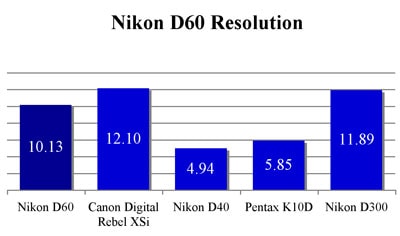
Look very closely at a digital photograph and you'll find tiny clumps and blotches, particularly visible in large solid-color areas that are either very light or very dark.This imperfection is called noise, caused by shortcomings in a camera's sensor and electronics.Every image sensor has an optimal light sensitivity level and, the further you push it beyond that spec, the more noise you see in the resulting image.Noise becomes more of a problem as you boost the ISO setting to take low-light photos without flash or when blowing up a small part of a captured image to substantial print size.
****Our testing procedure here requires multiple photos of a brightly lit color chart, systematically increasing the ISO level to produce a complete spectrum of test images, then analyzing these using Imatest to determine the noise level.The graph below displays two sets of results: one with camera's noise reduction processing on, the other with noise reduction off.

Nikon cameras generally perform very well when it comes to noise, and the D60 is no exception, shooting both with and without in-camera noise reduction processing turned on, at the full range of ISO settings.Turning the noise reduction setting on has little effect at low ISO settings, but from ISO 400 on, the improvement is significant.
The overall noise performance for the D60 is a major win versus the competition, significantly besting the Canon XSi and even surpassing the pricier Nikon D300. While the importance of color accuracy is arguable in real-world viewing, anyone who hopes to print photos larger than 4 x 6 size or regularly shoots in low light situations such as concerts and parties will recognize the benefit of minimizing image noise.

As an additional check, we test noise levels with the camera set to automatic ISO, a popular choice when shooting quickly in a variety of lighting conditions.Here the camera chose conservative ISO settings between 280 and 320, and again delivered very good noise performance.
White Balance (5.35)
Our eyes don't perceive the difference in the color of a light source – the greenish tinge of a fluorescent bulb, for example, versus the orange light from a household lightbulb – but our cameras certainly do, and compensate for the difference via a setting called white balance.Every consumer camera includes an automatic white balance function that meters the light conditions and adjusts accordingly. While this capability has improved dramatically in the past few years, there are still situations where the photographer will want more control over the white balance setting. For the D60, as with most SLRs, this includes several presets for different lighting situations plus the option to create a manual white balance by shooting a white or gray card and having the camera determine the appropriate setting based on that reference point.
The Nikon D60 has some problems with white balance, both on the auto setting and with the provided preset selections.Tungsten lighting (the kind produced by household bulbs) produces particularly poor results on the automatic white balance setting, which is problematic for available light photography. The automatic setting does produce a much more accurate result than the white balance preset, though, when shooting under fluorescent light.There's some logic to this, since the color temperature of fluorescents varies widely.The automatic setting also surpasses the preset in our daylight shade test, which is surprising.
*Preset (4.57)
*Based on our testing, using the tungsten preset is highly recommended when shooting with regular indoor light bulbs. Otherwise, just leave white balance on auto.
Still Life
To further test the Nikon D60, we took a variety of photos of a happily married couple and a still life scene at all ISO settings the camera supports. To view the original, full resolution version of any file, click on the image. However, remember that these files are very large (some are more than 4MB), so they may take a long time to download.
**Low Light **(7.72)
A camera's low-light performance has become a key differentiating factor when choosing between models.Improvements in sensor sensitivity and digital image processing let us successfully shoot without flash in situations that would been impossible just two or three years ago.This has led to fewer babies startled to tears by a flash in the face and kittens photographed with demonic glowing eyes, for which we are eternally grateful. While low-light performance has improved industry-wide, though, significant differences from camera to camera remain.
The D60 does well shooting in low light. The two desirable camera characteristics in low-light shooting are maintaining an accurate exposure and minimizing image noise.
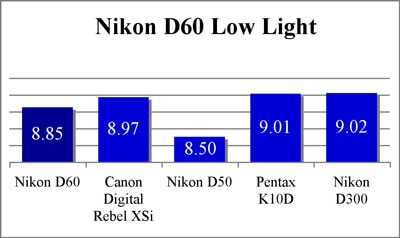
Even with a 30-second exposure time, images are well exposed and show little noise.In fact, noise performance is remarkably consistent across the entire range from 1 to 30 seconds, with and without in-camera noise reduction.
Dynamic Range (7.23)
The wider the dynamic range, the better the camera captures both the bright highlights in a scene and the dark shadow areas.To test dynamic range, we repeatedly photograph a backlit test strip with the full range of shades from pure white to pitch black.The resulting images are processed using Imatest software, which can determine the number of steps the camera successfully captured with more accuracy than the human eye.

The dynamic range for the D60 drops off very quickly as the ISO setting increases.We expect some deterioration at higher ISO settings, but the results here are worse than expected, leading to a loss of shadow detail when shooting in low light. The similarly-priced Canon XSi manages far superior performance here, nearly equaling the Nikon D300, while the D60 falls short of the scores recorded for its less expensive cousin, the Nikon D40.
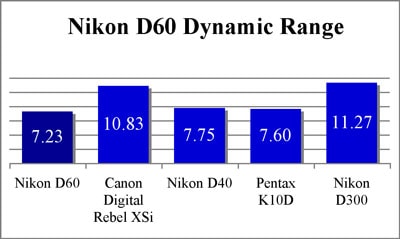
Speed/Timing
**Tests to determine the shooting speed of the D60 were conducted using a 2GB PNY SD card, shooting at default image settings (fine resolution, medium image size). Startup to First Shot **(9.20)
This test checks how quickly you can take your first photo after turning on the camera.The D60 performs well here, consistently squeezing off a first shot in less than half a second after flipping the power switch. This means you should be able to catch most candid shots without problems.
**
Shot-to-Shot (2.75)
Here we test the time between shots when holding down the shutter in Continuous Release mode.Nikon claims to capture up to 3 frames per second (fps).Our testing came up with just under 2.75 fps –a good result for an inexpensive SLR.
Shutter-Shot** (10.00)
The delay between the moment you press down on the shutter and the instant the picture is taken was too short to measure accurately – our results were consistently less than 0.2 seconds, which is a fine performance for a camera in this class.**
Processing** (4.79)
A few fractions of a second are consumed after every shot processing the digital information from the sensor, storing it on the memory card, and then displaying it on the screen – this is the time that elapses before a review image appears on the LCD screen.Here again Nikon's new processing chipset performs decently, taking an average of just 1.7 seconds between shooting the photo and seeing it displayed. That's a little slower than some, but it shouldn't prove to be a major problem for most users.
Components
Viewfinder*(7.75)*
The view through the D60's optical viewfinder is somewhat dark, thanks to the use of a mirror pentaprism instead of a more expensive glass pentaprism.Magnification, at 0.80x, is lower than other Nikons (the next step up on the food chain, the D80, offers 0.94-percent magnification) though we could see the entire image while wearing glasses.The optical viewfinder shows 95 percent of the recorded image, the standard spec for most DSLRs.The diopter control can be adjusted from -1.7 to +0.5m, with stronger adjustment available via accessory diopter adjustment viewfinder lenses sold separately.
At the bottom of the viewfinder a wide range of shooting details are displayed in clearly legible yellow over black.There are 25 items in all, including focus points, focus status indicator, shutter speed and aperture, shots remaining, flash ready indicator, battery level, and so on.In fact, all information shown on the rear panel while shooting is also displayed in the viewfinder, so you never have to look away from the subject while shooting.
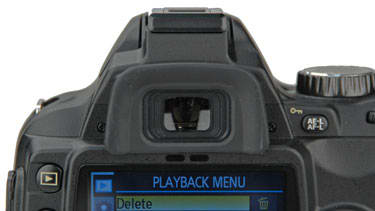
Sensors beneath the viewfinder turn the LCD off when you hold the camera to your eye.
Live View
The option to see what you're aiming at on the camera's LCD screen in addition to the optical viewfinder is becoming increasingly popular in SLR camera design.It's a feature with special appeal for those making the jump from a compact camera to an SLR, who are used to shooting while holding the camera at arm's length.And while SLR veterans are used to the secure, wiggle-free positioning of a camera at eye level, there are certainly circumstances where the freedom to move the camera instead of your whole body to frame a shot proves useful.With that in mind, manufacturers are increasingly building this feature into SLRs at several price levels, including the inexpensive Sony A300 ($700) and Canon's Rebel XSi ($800).Unfortunately, Live View isn't available on the D60 – in fact, it doesn't enter the Nikon line until you reach the $1,799 (body only) D300.
LCD Screen(4.25)
To keep the camera body small and eliminate an extra-cost component, Nikon didn't provide the standard monochrome LCD readout on top of the camera.Instead, the 2.5-inch, 230,000-pixel LCD serves two purposes: image playback and display of settings and readings while shooting.Neither extreme angles nor bright sunlight interferes noticeably with the screen's readability.LCD brightness can be set to one of seven levels based on your personal preference.Unlike other Nikons, the D40 doesn't come with a protective plastic screen cover.
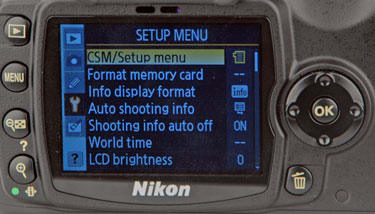
The 2.5-inch LCD is unchanged from the Nikon D40x.
For shooting purposes, the information display can be set to one of three formats: classic, graphic, and wallpaper.The classic mode replicates a straightforward numeric LCD display, with full readouts on shooting mode, shutter and aperture settings, battery strength, remaining exposures, flash settings, exposure compensation, Active D-lighting status, metering, autofocus, focus and release modes, ISO setting, white balance mode, image size, and image quality.
The graphic mode includes the same information, albeit smaller and arranged differently to accommodate a graphical representation of the aperture setting and shutter speed.The display is meant to bring home the relationship between the two settings for novice users.The aperture is represented by a traditional iris design, with the center hole enlarging for large aperture settings and shrinking for small ones.Around the aperture is a dotted line pattern representing shutter speeds: more dots indicate a faster shutter.
The wallpaper mode mimics the layout of the graphic display, but without the aperture/shutter speed graphic.Instead, the user can select a photo stored on the camera to be used as a backdrop.
The D60 relies on an internal sensor to flip the display from portrait to landscape based on the horizontal or vertical orientation of the camera, a welcome solution to the difficulty reading the D40 or D40x screen when shooting in portrait mode.

The rear display toggles between classic and graphic mode.
**Flash (7.50)
When raised, the flash stands roughly three inches above the center of the camera lens. The further the flash is positioned from the lens, the less likely you'll experience red-eye in portrait shots, and the distance here is effective in this regard. **When raised, the flash stands roughly three inches above the center of the camera lens. The further the flash is positioned from the lens, the less likely you'll experience red-eye in portrait shots, and the distance here is effective in this regard.
The built-in flash offers several modes:
- Red-Eye Reduction
- Slow Sync (for capturing background lighting at night)
- Slow Sync with Red-Eye Reduction
- Rear Curtain Sync (creating a streaking effect to convey movement)
- Normal Front-Curtain Sync
Overall, the D60 pop-up flash is worth having for convenience sake, but is no substitute for a full-fledged external unit. In shots of a light-colored wall from seven feet away, the illumination is noticeably uneven; brighter in the center and quite dark in the corners. This pattern makes it suitable for quick portraits or as a fill-flash when shooting a nearby subject outdoors, but inadequate for group shots.The D60 flash has a maximum guide number of 43 feet at ISO 100.
The earlier D40 and D40x models offer a maximum flash sync speed of 1/500 second, a significant benefit when using fill-flash for shooting on a bright day outdoors.Unfortunately, the D60 throttles back this performance spec to 1/200 second.
The system pops up the flash automatically in Auto, Portrait, Child, Close-Up and Night Portrait modes.For other modes, a small button to the left of the viewfinder pops the flash up and engages it.One of the Vari-Program settings on the mode dial lets you quickly keep the flash from firing, without bringing up the on-screen settings menu.
Flash compensation settings range from -3 to +1 EV in 1/3 EV steps, and work with the optional SB-400, SB-600, SB-800 and SU-800 flash units, as well as the built-in flash.
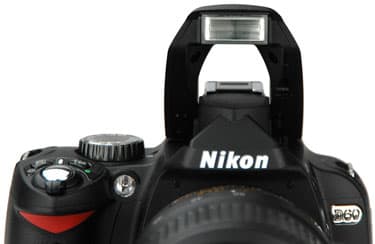
The relatively high flash position helps minimize red-eye.
Lens Mount(9.00)
There are two noteworthy issues with the D60 lens mount – the lack of in-camera image stabilization, and incompatibility with many existing Nikon lenses.
The kit lens for the D60 moves up to an AF-S DX Nikkor 18-55mm f/3.5-5.6G VR model, which incorporates Nikon's vibration reduction technology for image stabilization.Several cameras competing in this class, though, including the Sony A200 and the Olympus E-510, have adopted in-camera sensor-shift stabilization, providing the benefits of shake reduction with any lens.
As for compatibility, the D60 doesn't include a focusing motor, meaning only AF-S and AF-I lenses (which incorporate their own focusing motors) will be fully compatible with the camera.Type G or D AF Nikkor lenses can be mounted on the camera and focused manually, while non-type G or D AF Nikkor lenses also lose support for 3-D color matrix metering.If you already own a range of Nikon lenses, this is a significant consideration.On the other hand, for most prospective D60 buyers, the wide array of available AF-S close-up, telephoto, and zoom lenses should prove perfectly adequate, though there are holes in the lineup when it comes to wide-angle and low-aperture support.
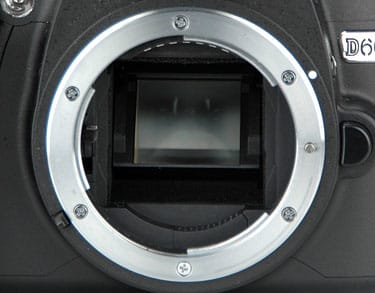
Lack of a built-in focusing mirror limits
compatibility with older lenses.
Design / Layout
Model Design / Appearance*(7.00)*
The look of the D60 reflects the professionalism and restraint typical of the entire Nikon line.Just because you spent $1000 less than the D300 buyer doesn't mean you get a camera that looks low-rent.
The plastic body inevitably has a less luxurious feel than a higher-priced camera – tapping on the handgrip with your fingernails results in a distinctly hollow rat-a-tat.Still, all the seams and joints are tight and secure enough for regular day-to-day shooting, and while the camera body is lightweight, it has a comforting heft in your hand.
Size / Portability (9.00)
Size is both a blessing and a curse with this camera, depending on the individual shooter.The D60 measures 5.0 x 3.7 x 2.5 inches (126 x 94 x 64mm) and weighs just 1 pound, 1 ounce (495 grams) without battery, memory card, or body cap.Add the 18-55mm kit lens and you're still tipping the scales at about 1 pound, 10 ounces (760 grams) – a very petite package.That's great when you're packing for a trip, or even want to stash an SLR in your shoulder bag or briefcase instead of a separate camera bag.
Handling Ability(5.50)
The highly-portable size of the D60 becomes a liability for those of us with large hands.Clutching the handgrip, there's really no room for your pinky – we found the most practical answer is to curl it up under the camera, as a sort of auxiliary support, but this is far from a perfect solution.The narrow grip leaves an uncomfortable gap between the left side of the camera and the palm, making for a cramped hand position and an insecure feel when shooting one-handed.Granted, paw sizes vary widely – a female office-mate was quite pleased with the way the camera fit her more modest grip.The moral: take the D60 for an in-person test-grab before making a purchase decision.
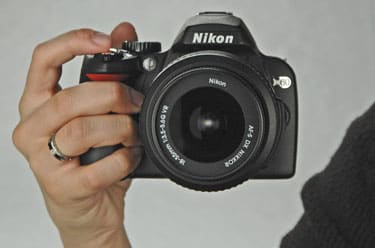

Coming to grips with the D60's small size can be problematic.
**Control Button / Dial Positioning / Size **(8.50)
The button and control arrangement is clear, well marked, and easy to use.There's no mushiness or second-guessing when hitting a button – you know instantly when it's been successfully depressed. Beginners will also appreciate the availability of a help display when changing settings(it's brought up on the LCD screen by pressing the zoom out button, marked with a '?' to indicate this auxiliary function).It's no substitute for the manual, but much better than nothing.
The D60 has a single command dial, mounted on the back, while more sophisticated Nikons use a pair of dials (the second located on the front of the camera, below the shutter release).The use of two dials does speed certain setting adjustments.For example, shooting in Manual mode with the D60 requires the user to hold down the exposure compensation button while turning the dial to adjust aperture.
There is only one programmable button, located on the left side of the lens mount and assigned to turn on the self-timer by default (it's marked with an abstract clock logo).This button can be programmed to work in conjunction with the command dial to set release mode, image quality, ISO speed, or white balance.
It may seem like a small point, but Nikon's straightforward approach to getting rid of a bad photo deserves some praise here.There's a single button (located below the four-way control dial), emblazoned with a trash can icon.Press it once while reviewing your photos and you get an on-screen 'Delete?' confirmation message.Press it again and the photo is gone.Other cameras require more elaborate button combinations to delete a picture, presumably slowing you down for your own good.A quick double-tap of a single, clearly-labeled button to send a crap shot to the digital graveyard is both faster and more efficient.

Controls are well marked and easy to use.
Menu (8.00)
The menu structure is straightforward and well organized, with a combination of legible text and helpful on-screen icons.From top to bottom, the section menu choices include Playback, Shooting, Custom Settings, Setup, and Retouch.Using the four-way controller, you move the cursor to the far-left icon column to choose the appropriate menu section, then move right to choose a subcategory, then right again to open up your settings choices.It's an intutive and effective layout.
**Shooting Menu **

**Custom Settings Menu **

**Setup Menu **

**Retouch Menu **

Ease of Use (9.00)
The D60 makes a nice bridge camera for someone moving from a compact camera to the SLR format.The automated settings produce consistently good results under most shooting conditions and, even when the defaults lead to faults in the recorded image (off-white whites, for example), these are ordinarily a snap to repair using Quick Fix on an entry-level image editing program.The inclusion of compact-camera-like pre-programmed settings for common shooting situations is a useful step up from full-auto shooting to more controlled photography, and the onboard help system is a welcome feature for those learning to use the more sophisticated SLR control palette.
The D60 makes a nice bridge camera for someone moving from a compact camera to the SLR format.The automated settings produce consistently good results under most shooting conditions and, even when the defaults lead to faults in the recorded image (off-white whites, for example), these are ordinarily a snap to repair using Quick Fix on an entry-level image editing program.The inclusion of compact-camera-like pre-programmed settings for common shooting situations is a useful step up from full-auto shooting to more controlled photography, and the onboard help system is a welcome feature for those learning to use the more sophisticated SLR control palette.
The D60 makes a nice bridge camera for someone moving from a compact camera to the SLR format.The automated settings produce consistently good results under most shooting conditions and, even when the defaults lead to faults in the recorded image (off-white whites, for example), these are ordinarily a snap to repair using Quick Fix on an entry-level image editing program.The inclusion of compact-camera-like pre-programmed settings for common shooting situations is a useful step up from full-auto shooting to more controlled photography, and the onboard help system is a welcome feature for those learning to use the more sophisticated SLR control palette.

Modes
Drive / Burst Mode*(6.50)*
Nikon says the D60 can churn out up to 3 frames per second, and we got close to that figure in our testing.The maximum number of JPEGs in continuous shutter release mode is 100 shots, regardless of resolution or compression settings.In RAW format, the buffer will fill after only six shots.The number of frames remaining before the memory buffer fills and frame rate slows is shown on the right side of the viewfinder display.
**Playback Mode ***(9.75)*
A single clearly-labeled button starts full-screen playback, beginning with the most recent shot.Toggling the four-way control up and down overlays information displays over the image, including three screens of shooting information readouts, a display revealing blown-out highlights, and a histogram.
You can zoom in up to 25x during playback, making it easy to determine the sharpness of a given image.We particularly like one innovative zoom feature: after setting the area you want magnified, you can scroll through images using the control dial, maintaining the same positioning and magnification for each sequential picture.This is a fast, convenient way to determine the best shot in a sequence.
Pressing the zoom out button brings up a multiple thumbnail image display: first four images, then nine, which can be browsed with the four-way controller and selected for full-screen display by pressing the OK button.
The D60 also provides extensive in-camera editing options, which is covered below in the Picture Quality / Size Options section.
Custom Image Presets*(6.00)*
As a hand-holding convenience, the D60 provides six image pre-programmed image setting combinations, accessible via the mode dial: Portrait, Landscape, Child, Sports, Close-Up, and Night Portrait.
When we asked Nikon to explain exactly which settings are tweaked how for each of these presets, we were told the specifics are 'confidential.'However, the aperture/shutter speed combinations required are straightforward: boost shutter speed for fast-moving sports and children, ratchet down the aperture setting for landscapes, set flash to slow sync for night portraits.Beyond that, Nikon says auto white balance is used for all modes, and switches between the two available sRGB color spaces depending on the scene.Tone compensation and sharpening are the other two variables that change from preset to preset.Sharpening is lower for Night Portrait and Portrait modes, while Landscape and Sports modes have a higher level of sharpening to bring out fine details.Tone compensation (contrast levels) are also adjusted based on the preset.
Control Options
Manual Control Options
Manual controls are available for aperture and shutter speed, white balance, ISO, and focus.Full Manual control mode, along with Shutter and Aperture Priority modes allowing the user to set one parameter and have the camera set the other to achieve acceptable exposure, are available by turning the mode dial to M, S, or A respectively.
Focus
Auto Focus (6.00)
The D60 system provides just three autofocus points, arrayed along the central horizontal axis.This represents a serious performance limitation, especially when shooting moving subjects using continuous focus mode – the odds are small that a running athlete, for example, will follow a nice straight horizontal path across the frame.By way of contrast, both the Sony A200 ($600 with lens) and the Canon EOS Rebel XTi ($600, body only) provide nine autofocus points.
There is an autofocus assist lamp on the front of the camera, below the mode control dial, which is triggered automatically when needed.
Manual Focus (6.00)
A switch on the barrel of the kit lens enables Manual focus mode.The on-screen display is adequate for judging sharpness, though the lack of resistance while turning the focusing ring makes finding and keeping the right point twitchy.There is no electronic focus indicator in Manual mode, nor a depth of field preview button to stop down the lens and reveal the actual area in focus at a given aperture setting.
ISO (8.00)
Like the D40x, available ISO settings for the D60 range from 100 to 1600 in full-EV increments (i.e., 100, 200, 400, etc.) plus the coyly named Hi 1 setting, effectively a full stop more sensitive than ISO 1600 yet not called ISO 3200, presumably because the engineers don't want to promise full ISO 3200 performance when pushing the sensor to this level. It would be preferable to have ISO settings available in smaller increments.
Noise reduction is optional at ISO settings of 400 or higher.Even when this noise reduction function is turned off, some noise reduction processing is still performed when the ISO is set to 1600 or Hi 1.Using noise reduction slows shot-to-shot time due to the processing time required.
White Balance (6.50)
In addition to the default Auto white balance, manual setings for Incandescent, Fluorescent, Direct Sunlight, Flash, Cloudy, and Shade are readily available via the Quick Settings display.You can also perform a manual white balance adjustment by photographing a gray or white card, or using an existing photo.Only one manual white balance setting can be stored at a time.
Exposure (9.00)
Shutter Priority, Aperture Priority, and fully Manual exposure settings are available via the top-of-camera mode dial.In Auto and Program mode, where the camera sets shutter speed and aperture, exposure compensation is still available, from -5 to +5 EV, in 1/3 EV steps, by holding down the exposure compensation button and turning the command dial.
Metering (7.50)
The default choice is matrix metering, which uses a 420-pixel RGB sensor to read a wide area of the frame.According to Nikon, 'The D60's 3D Color Matrix Metering II evaluates each scene for brightness, color, contrast, size, and position of shadows and highlights, selected focus area and camera-to-subject distance, comparing that information against an onboard database of more than 30,000 actual photographic scenes. The result delivers instantly and precisely determined exposures for each scene, even in challenging lighting conditions.'In practice, we found the metering works fine in well-lit scenes, but has difficulty finding a reasonable balance in high-contrast situations.
Alternatively, you can choose center-weighted metering, which reads the full frame but adjusts exposure to favor the middle area, or spot metering, which reads only the active focus point.
Shutter Speed (10.0)
Available shutter speeds range from 1/4000 to 30 seconds in 1/3 EV steps (i.e., 1/3-, 1/40, 1/50, etc.), a finer gradation than found on some midrange SLRs, plus 'Bulb' for lengthy exposures.
Aperture
The D60 offers electronic aperture control with most CPU lenses.The kit lens, an 18-55mm zoom, offers an aperture range from f/3.5 – f/5.6.
Image Parameters
Picture Quality / Size Options (7.50)
The Nikon D60 shoots in three image sizes:
- 3872 x 2592 (10.0 MP)
- 2896 x 1944 (5.5 MP)
- 1936 x 1296 (2.5 MP)
Picture Effects Mode (10.75)
This camera offers an exceptional array of photo manipulation tools - some useful, some slightly goofy - both while shooting and through the in-camera Retouch menu for existing shots.
Image optimization choices include:
- Normal (default)
- Softer (wrinkle-forgiving portrait mode)
- Vivid (boosts reds, greens and blues, enhances contrast, saturation and sharpness)
- More Vivid (maxes out the above effects)
- Portrait (lowers contrast and softens skintones)
- Black and White
- Custom
The 'Custom' setting allows meticulous control of image sharpening, tone compensation, saturation, and hue.Users can also choose from three alternative color spaces: two flavors of sRGB (one recommended for portraits, the other for landscapes and outdoor shooting) along with Adobe RGB, used primarily in publishing and commercial printing.
The camera also supports Active D-Lighting, an image enhancement technology that brightens shadow areas and lowers highlight glare automatically after shooting.The effect is also available for existing photos via the Retouch menu.
In-camera editing is a decided strength of the D60 – you can amuse yourself for hours on the flight home from your next vacation trip fiddling with your photos, without ever firing up a computer.
Your choices for road-warrior photo manipulation include:
- Quick Retouch: automatically create a copy with contrast and saturation enhanced and D-Lighting (see below) applied. Three levels of correction are selectable.
- D-Lighting: brightens shadow areas, available at three enhancement levels
- Red-Eye Correction
- Trim: In-camera cropping.
- Monochrome: creates copies in black-and-white, sepaia or cyanotype (blue-tinted)
- Filter Effects: These include skylight (slightly filters out blue), warm (adds orange/red cast), red, green and blue intensifiers, and a cross screen that adds star glints to an image, if you're into that sort of thing.
- Small Picture: save a lower-res copy at one of three sizes, for TV playback, web posting or e-mailing.
- Image Overlay: Combine two RAW images.
- NEF (RAW) Processing: adjust the image quality, image size, white balance, exposure compensation and image optmization settings for a RAW image and save the result to a JPEG.
- Stop-motion Movie: string together multiple stills, save results as an AVI file.
Connectivity / Extras
Connectivity
Software (4.00)
The Nikon Software Suite supplied with the camera includes two programs, both with versions for Windows and Mac OS:
- View NX: Provides basic image browsing and organizing functions and RAW to JPEG conversion with basic image parameter adjustments.
- Nikon Transfer: transfers images from the camera or a card readers to your computer, though why you'd use this instead of the operating system utilities is unclear.
*

Jacks, ports, plugs* (2.00)
On the left side of the camera, under a flip-up door, are connections for a video-out cable and a mini-USB jack. Video output is standard-definition only, with no support for HDTV. Surprisingly, the video-out cable is not included with the camera, an annoying piece of skinflintery in a $750 purchase.
Direct Print Options (7.50)
The D60 can be connected via the USB port to a PictBridge-compatible printer for outputting JPEGs directly (RAW files require computer software for printing).Photos can be printed individually, as a group via selection from a thumbnail display on the LCD, or via a DPOF print order creating on the camera (which lets you choose the number of prints desired for each included image).You can also print a contact sheet with thumbnail images of JPEG photos directly from the camera.
Battery (7.00)
The familiar 7.4-volt 1000mAh EN-EL9 lithium-ion battery carries over from previous models – a good thing, since it guarantees ready availability of replacements or spare batteries if needed.Nikon claims 500 shots per charge, which seems about right based on our experience during testing. *Memory* (4.00)
The camera accepts both standard SD and high-capacity SDHC cards.The card slot is located on the right side of the camera, under a ridged door that slides open easily with a little thumb pressure, but is unlikely to be opened accidentally.
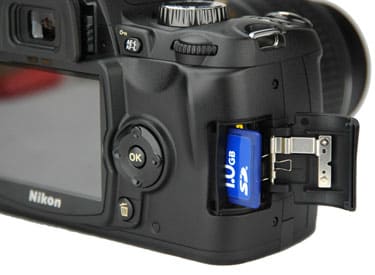
The D60 is compatible iwth SDHC cards, which enables
huge shooting capacity.
Other features (6.00)
*Dust Reduction *– The D60 inherits the Active Dust Reduction System introduced earlier this year in the far more expensive Nikon D300.By default,low-pass filter protecting the image sensor vibrates each time you turn the camera on or off.There's also an airflow system that blows dust onto a sticky strip and out of the way.
*Digitutor - *The production values are reminiscent of a 1950s-era industrial film, but the model-specific video tutorials Nikon offers on the Web (nikondigitutor.com/eng/d60/index.shtml) do a nice job explaining a wide range of topics.They start out basic, which is the right idea for the target audience (no, it's not that easy installing the camera strap if you've never done it before, and the animated explanation here is much easier to follow than a static diagram in the manual).Keep going and you get to some potentially intimidating topics, such as Nikon's D-Lighting technology and shooting in RAW format, explained well. This is a valuable free addition to the straightforward product manual, and we applaud Nikon for investing in educating its customers.
Overall Impressions
Value (5.00)
The D60 carries a suggested retail price of $750 and, like all digital cameras, can be found for less.For the price you're getting all the image resolution you're ever likely to need, with a high-quality lens and pleasing responsiveness while shooting.Incompatibility with some Nikon lenses is a black mark for prosumers but, for the intended market of amateurs eager to step up from a compact to a higher-performing SLR, we think the D60 is an acceptable, but not outstanding, value.
Comparisons

**Nikon D40 – **Even as it adds new models, Nikon continues to offer the D40, which hit stores shelves in 2006 – and no wonder.At less than $500 with lens, it's a tempting entry-level choice.Yes, the resolution is 'only' 6.1 megapixels, but unless you're planning prints larger than 11 x 14s, that's a completely acceptable figure.If you find the size and portability of the D60 alluring, the D40 matches it millimeter for millimeter.The mode selections (Portrait, Landscape, etc.) that comfort users moving up from compact point-and-shoots are here, too.On the other hand, the same autofocus system limitations plague both models, the D40 handles noticeably slower than the D60, and image quality doesn't stand up to close inspection, though it's fine for snapshot shooters.

***Pentax K10D* – **Available for less than $1000 with an 18-55mm lens, the 10-megapixel K10D offers several features we missed on the D60 for not a lot more money.The weatherproof body is solidly built, standing up to the dust and water hazards encountered in an active lifestyle.The 11-point autofocus system performed well in our testing, and in-camera image stabilization makes inexpensive lenses a viable option.A raft of control features and options do make the K10D more difficult to learn for beginners, though, and while image quality is acceptable, it tested no better than the D60.

Nikon D300**–** This 12.3-megapixel model, priced at $1,799 without a lens, stands at the opposite end Nikon's consumer line, but it illustrates the compromises involved in choosing the D60.The D300 is built to take rough handling when necessary, with a solid construction and size that feels good in a man's hands.The pro-quality autofocus system is lightning-fast and includes 51 focus points versus the D60's three.It features a superior high-res 3-inch LCD with live view when shooting, and image quality was consistently excellent in our tests.Of course, the price difference is huge, but the D300 is a camera you're not likely to outgrow.

Canon XSi** –** The XSi is similar to the D60 in many ways; it has a similar price, broadly similar feature set and is aimed at much the same point-and-shoot users looking to upgrade. And some of the upgrades that the two cameras offer are the same; both have optical image stabilization in the kit lens. But the XSi has a number of advantages over the D60, such as better overall imaging performance, live view, and a bigger LCD screen. With only a slight price difference between the two cameras, the deciding factor may be brand loyalty; if you already have Nikon lenses and acessories, the D60 would be a good pick. But if you have Canon lenses, the XSi would be the better choice.
**
Who It’s For ***
Point-and-Shooters* – The automatic controls work well, the price is right, and fun features like in-camera editing should also appeal to casual users.The Digitutor online video tutorials are a nice bonus for this group.However, SLRs with live view on the LCD while shooting may have more appeal when stepping up from a compact camera.
Budget Consumers – There are less expensive models available for penny-pinching consumers, including Nikon's own still-popular D40 at less than $500, offering the same core features, albeit at a lower resolution.
Gadget Freaks – Nothing here to inspire hardware lust.
Manual Control Freaks – The manual controls are probably more extensive than necessary for the target market, but the settings-obsessed will do better elsewhere.
Pros / Serious Hobbyists – If you're a Nikon shooter, there are other reasonably low-cost cameras in the line (the D80 comes to mind, at just $50 more) offering better compatibility with the range of Nikon lenses and more robust construction.
Conclusion
**
Conclusion**

The Nikon D60 sits in an odd niche in the market.It's not the least expensive well appointed digital SLR you can buy, and for just a few dollars more you can buy a substantially superior camera. The VR lens is a big step up from previous inexpensive Nikons, but the competition is selling cameras with anti-shake technology built into the camera body at roughly the same price (including the Sony A200 at $600 and the Pentax K200D at $799). Imaging performance shines when it comes to noise, and the responsiveness while shooting is exceptional for a camera in this class.However, the D60 also lagged in several equally important areas, including white balance and dynamic range.As for the strikingly small size, that's a win for some users, a loss for others.
Bottom line: it's a good camera, and you can take handsome photos with it, but it's not our top choice in the increasingly competitive field of inexpensive SLRs.
Sample Photos
**Sample Photos
Click on any of the images below to view the full-sized origional image. However, please note that some of the images are extremely large (up to several megabytes) and could take a long time to download. **
**
**You can browse photos taken with the Nikon D60 on the following photo hosting sites:
[

](http://search.fotki.com/?q=D60)[

](http://www.smugmug.com/search/index.mg?searchWords=D60&searchType=global&x=0&y=0)****
Specs / Ratings
**Specs Table
**{{manufacturer_specs_table}}{{raw_scores_table}}
Meet the tester

Steve Morgenstern
Editor
Steve Morgenstern is a valued contributor to the Reviewed.com family of sites.
Checking our work.
Our team is here to help you buy the best stuff and love what you own. Our writers, editors, and experts obsess over the products we cover to make sure you're confident and satisfied. Have a different opinion about something we recommend? Email us and we'll compare notes.
Shoot us an email